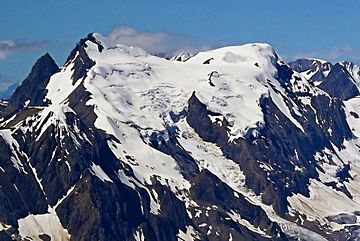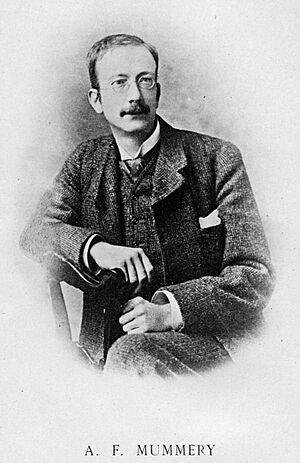Mount Mummery facts for kids
Quick facts for kids Mount Mummery |
|
|---|---|

Mount Mummery, east aspect
|
|
| Highest point | |
| Elevation | 3,331 m (10,928 ft) |
| Prominence | 481 m (1,578 ft) |
| Parent peak | Mount Barnard (3340 m) |
| Geography | |
| Location | British Columbia, Canada |
| Parent range | Freshfield Icefield Ranges Canadian Rockies |
| Topo map | NTS 82N/10 |
| Geology | |
| Age of rock | Cambrian |
| Type of rock | Sedimentary |
| Climbing | |
| First ascent | 1906 |
Mount Mummery is a tall mountain in the Canadian Rockies, located in British Columbia, Canada. It stands 3,331 meters (about 10,928 feet) high and has two main peaks. This mountain is covered in glaciers and is the highest point in its local area, known as the Mummery Group. It is also the fourth-highest peak in the Freshfield Icefield Ranges.
Mount Mummery is about 42 kilometers (26 miles) north of Golden. It sits near the southern edge of the Freshfield Icefield, in the Blaeberry Valley. The mountain is also less than 4 kilometers (2.5 miles) from the Continental Divide, which separates rivers flowing to different oceans.
The mountain was named in 1898 by J. Norman Collie. He named it after Albert F. Mummery (1855-1895), a famous British mountaineer. Mummery was lost while trying to climb Nanga Parbat in the Himalayas. J. Norman Collie was a climbing friend who was with Mummery on that expedition. Collie named many peaks in the Canadian Rockies. Around the same time, a nearby peak was also named Nanga Parbat Mountain. The name Mount Mummery became official on March 31, 1924, approved by the Geographical Names Board of Canada.
The first time climbers reached the top of Mount Mummery was in 1906. The climbing team included I. Tucker Burr Jr, Samuel Cabot Jr, W. Rodman Peabody, and Robert Walcott. They were guided by Gottfried Feuz and Christian Kaufmann.
Mountain Weather and Rivers
Mount Mummery is in a subarctic climate zone. This means it has very cold, snowy winters and mild summers. Temperatures can drop below −20 °C (or −4 °F). With wind, it can feel even colder, below −30 °C (or −22 °F).
Water from the melting snow and ice on Mount Mummery flows into nearby rivers. The Mummery Glacier also melts, adding to this water. This water eventually drains into the Blaeberry River and Waitabit Creek. Both of these are smaller rivers that flow into the larger Columbia River.




